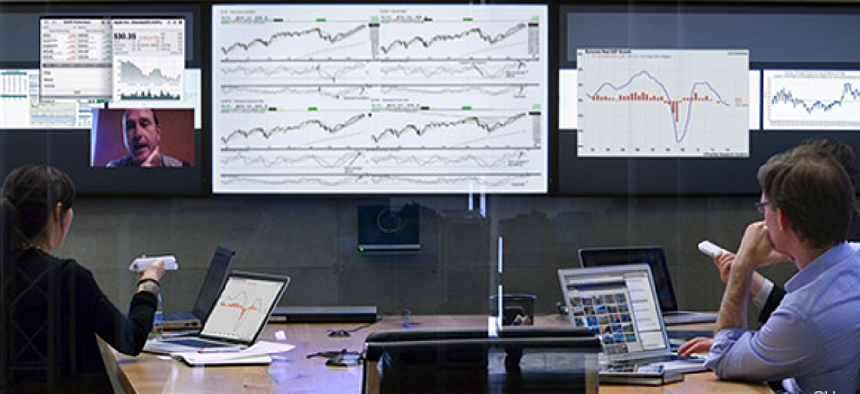'Minority Report' gets real with gesture tech platform


Connecting state and local government leaders
Mezzanine, a commercial version of the interfaces Tom Cruise used on screen, helps agency teams collaborate, gain situational awareness.
When Tom Cruise waves his hands in the 2002 film “Minority Report” and manipulates data on multiple screens, it’s the stuff of science fiction. Today, though, movie stars aren’t the only ones using gestural technology -- government agencies are, too.
John Underkoffler, CEO of Oblong Industries, created the futuristic technology for the blockbuster film, and for years, it was available only as a custom solution. In 2012, however, Oblong released Mezzanine, a commercial version that about a dozen agencies have picked up so far.
“Steven Spielberg came calling and said basically, ‘Can you tell me what computer interfaces are going to look like in 50 years?’” said Michael Friedel, Oblong’s federal director. “They came up with the glove-based gestural system – being able to orchestrate massive amounts of data visually without ever touching a screen or a keyboard or a mouse.”
Basically, users wear a glove – or use a wand – to manipulate information on multiple screens using gestures. Available in several options, the out-of-the-box Mezzanine solution comes with two wands and the main appliance. To use it, customers need bandwidth of 15 megabits up and down, high-definition screens and videoconferencing equipment. Mezzanine supports any standards-based camera and codec system.
But this gestural technology is about more than videoconferencing, Friedel said. Although it lets meeting participants see one another via video feeds, the differentiator is how it lets them work with the same data in real time.
“That’s what we call infopresence,” he said. “It’s one thing to be able to do videoconferencing, which a lot of people do today, but it’s another when you take collaborators in multiple locations and you start sharing content data across time and distance.”
Mezzanine is built on g-speak, a platform that allows an unlimited number of devices and screens to be used together. It supports almost all data, including hard data such as charts. To insert hard data into a workflow, users take a picture of it and it becomes part of the system, Friedel said.
Customers use Mezzanine in three main ways, he explained. One is for executive briefings or customer presentations. Another is for collaboration because a group of local or dispersed users can get together to manipulate many data sources, such as PDFs, JPEGs, reports, analytics and websites.
“It will accept any data, any content from any application, and there’s no integration services that are required to do that,” Friedel said. “All that’s required is for somebody to come into a room, connect either via direct video connection, connect via the web browser, connect wirelessly.… They can either control the session, or they can contribute.”
But users don’t have to be in the same room to collaborate. They can connect remotely and from one Mezzanine-enabled room to another.
The third common use case – one the military especially employs, Friedel said – is on-demand, real-time situational awareness. For example, it’s helpful in crisis or emergency management, when many agencies need to work together efficiently.
Additionally, intelligence entities are using Mezzanine to study human performance responses, such as how long an analyst studies something and what causes the person to shift focus.
Mezzanine rooms start at $150,000 and can cost as much as $250,000, depending on what’s needed. A room typically consists of three high-definition dynamic screens – totaling about 6 million pixels – and three other screens called corkboards because they hold static images for future use. Information flows into the appliance via a variety of connected devices, and the appliance represents the data on the dynamic displays and corkboards.
As changes to the data occur, all users see it at the same time. What’s more, Friedel said, if people in one Mezzanine room have an application that the users in another lack, that second group can use the wand to essentially reach through and access that application.
“It’s almost like a video game,” he said. “You point and click on the wand and there’s a couple basic functions that you can perform. One is you can add content, you can stretch content, you can zoom in, you can cut and paste that content.”
Mezzanine is an iterative working model, which means it saves sessions so that users can start where they left off when they return. The digital workspace has 2 terabytes of local storage space with full failure redundancy.
Mezzanine provides a high return on investment, Friedel said. For one, it saves agencies on middleware costs because it requires no middleware, whereas connecting two or more applications or environments -- such as data warehouses, enterprise resource planning systems or business intelligence systems --usually requires a significant amount. Additionally, it removes the need for employees to travel to attend meetings, cutting travel costs and increasing productivity.
Looking ahead, Oblong officials want to enable users to walk into a Mezzanine room, present an ID card such as a Common Access Card and automatically receive the information in which they’d be interested. They also plan to offer a modular design to make Mezzanine more scalable.




